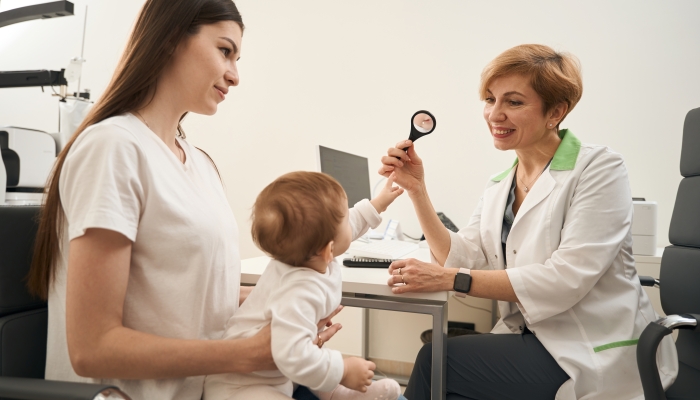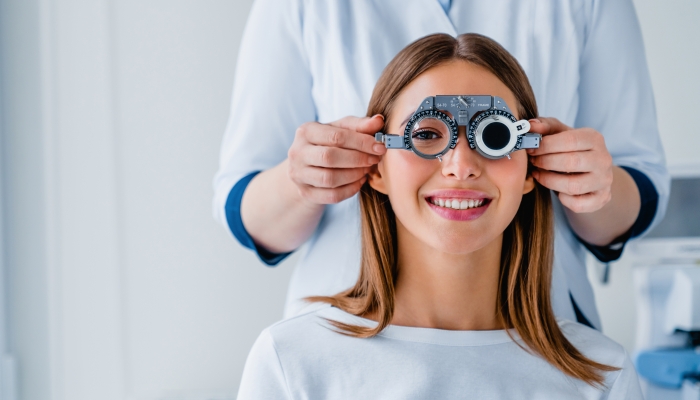Aniridia: A Closer Look at Congenital Absence of the Iris and Its Effects on Vision

- Aniridia is a condition where a person is missing the iris, or colored part of the eye.
- The iris is a group of muscles responsible for dilating and constricting the pupil.
- Aniridia can cause blurred vision, light sensitivity, or even blindness.
- Most children with aniridia retain some visual acuity and can attend regular school.
Finding out that your child has a congenital eye problem is enough to make any parent feel anxious, upset, and maybe even hopeless. Every parent wants their child to be happy and healthy, and having a child with vision problems may feel like an impossible challenge.
Aniridia is one of those conditions that can lead to vision problems ranging from mild blurry vision to complete blindness. Fortunately, both research and resources continue to progress to improve the quality of life for children with vision problems and their families.
Parents of children with aniridia can help their children by learning more about the condition, working closely with their care team, and utilizing available resources for their children and themselves.
Aniridia: What Parents Need to Know

Aniridia is a rare genetic disorder that causes partial or complete absence of the iris, or colored part, of the eye. It usually runs in families and is passed down from parents to their children. Children with aniridia can struggle with problems like high intraocular pressure, cataracts, and vision loss.
Aniridia almost always affects both eyes, but the severity may be different in each eye. Many people with aniridia have problems with other parts of the eye in addition to the iris defects.
Aniridia may be confused with iris coloboma. While they are similar, aniridia affects the entire iris of the eye, while iris coloboma only affects a small part of the iris. Iris coloboma gives a person a “cat-eye” pupil.
What Causes Aniridia?

The American Association for Pediatric Ophthalmology and Strabismus11. Aniridia. American Association for Pediatric Ophthalmology and Strabismus. 2023. https://www.aapos.org/glossary/aniridia states that aniridia only occurs in about 1 out of every 50,000 to 100,000 births. Despite being such a rare disease, scientists have been able to research and discover many of the genes associated with the condition.
Genetic Factors
Genes are like an instruction book for the body cells to build tissues, organs, and other parts of the body. According to the American Academy of Ophthalmology22. Ahmed, N. R., Tandon, R., & Vanathi, M.. Diagnosis and Management of Aniridia. American Academy of Ophthalmology. 2016. https://www.aao.org/eyenet/article/diagnosis-management-of-aniridia, the primary gene responsible for dictating the morphology of the eye is the PAX6 gene, located on chromosome 11p13. When part of this specific gene is missing or in the incorrect order, aniridia may result. Other genes that are associated with aniridia include FOXC1, PITX2, and PITX3.
These genetic problems can be passed down from parent to child or can be the result of a mutation. Two-thirds of cases of aniridia are passed down through the PAX6 gene, while about one-third are caused by a mutation. Mutations may happen spontaneously or may be the result of exposure to harmful environmental factors like radiation, certain drugs and medications, or toxic chemicals.
Children born with WAGR syndrome have a higher risk of developing aniridia. The Genetic and Rare Diseases Information Center33. U.S. Department of Health and Human Services. WAGR syndrome. Genetic and Rare Diseases Information Center. https://rarediseases.info.nih.gov/diseases/5528/wagr-syndrome states that children born with WAGR syndrome also have an increased risk of mental retardation, genitourinary abnormalities, spinal cord problems, and hearing abnormalities.
Trauma
Some people are not born with aniridia but develop it later in life. BMC Ophthalmology44. Ichioka, S., Ishida, A., Sugihara, K., Sano, I., & Tanito, M.. Isolated traumatic aniridia with full and partial Iris expulsion in Pseudophakic eyes. BMC Ophthalmology. 2022;22(1). https://doi.org/10.1186/s12886-022-02615-4 presents a study where two women developed aniridia after a traumatic accident. This problem is more common in people who have already undergone cataract surgery.
Pathophysiology: How Aniridia Affects the Eye

Aniridia affects both the structure and function of the eye. People with aniridia may have iris hypoplasia, meaning their iris tissue is very small, or they may have no iris tissue at all. Either way, their eyes will not have the same appearance as those who do not have the condition.
People with aniridia will have eyes that are completely black since the colored part of the eye is missing.
In addition to changing the appearance of the eye, aniridia also affects its function. The iris of the eye is actually a muscle that controls the dilation and constriction of the pupil. This means that patients with aniridia usually have problems with light sensitivity because they cannot constrict to allow less light inside the eye.
In addition, patients with aniridia have difficulty focusing on objects that are very near or far away, because their eyes cannot adjust well. In severe cases, aniridia can cause complete vision loss.
People with aniridia often also have other eye conditions such as:
- Cataracts
- Glaucoma
- Corneal abnormalities
- Optic nerve hypoplasia
What Are the Signs and Symptoms of Aniridia
Aniridia can be diagnosed soon after a baby is born.
In Newborns

It may not be obvious when a brand-new baby has aniridia. Most pediatricians will perform a thorough eye exam soon after your baby is born.
Signs to look for in neonates include:
- No color where the iris would normally be
- Photophobia (light sensitivity)
- Nystagmus (when eyes move rapidly back and forth)
- Abnormal pupillary response
Babies may be born with isolated aniridia, meaning their congenital problems only affect the iris. However, many babies born with aniridia should be tested for other conditions such as Gillespie syndrome.
In Adults

Most adults already know that they have aniridia. It is rare for a person with aniridia to reach adulthood without having a diagnosis in childhood.
Signs and symptoms of aniridia in adults include:
- Poor vision
- Low visual acuity
- Light sensitivity
- Cataracts or corneal opacity
- Glaucoma
How Is Aniridia Diagnosed?

A diagnosis of aniridia can be made by your child’s pediatric ophthalmologist. There are several ways to confirm a diagnosis of aniridia.
Clinical Examination
Aniridia patients will first undergo a clinical examination. A clinical examination may include sit-lamp biomicroscopy or fundoscopic examination.
- Slit-lamp biomicroscopy uses a focused beam of light to allow the doctor to see all parts of the eye.
- Fundoscopic examination allows the doctor to see the fundus of the eye and can diagnose aniridia, high blood pressure, diabetes, endocarditis, and other conditions.
Genetic Testing
To perform genetic testing, your child’s healthcare provider will send a blood sample to identify PAX6, FOXC1, PITX2, and PITX3 mutations. This can help to determine whether your child has autosomal dominant aniridia.
Imaging Techniques
- Optical coherence tomography (OCT) takes images of the retina and can be used to diagnose glaucoma.
- Ultrasound biomicroscopy uses high-frequency ultrasound to view the anterior chamber of the eye. It’s used to diagnose and grade the severity of glaucoma.
Conditions Associated with Aniridia
Children born with certain conditions have a higher risk of being born with aniridia. These include:
- Autism spectrum disorders
- Gillespie syndrome
- Cerebellar ataxia
- Wilms tumor
Very young children with these conditions should be carefully screened for aniridia and other eye problems to help them deal with early development problems and avoid potential complications.
Management and Treatment
The management and treatment of aniridia varies. Treatments can range from neonates needing early surgical interventions to simply needing glasses or contact lenses. Parents should work closely with their child’s pediatrician to find the best treatment options for their little one.
Pediatric Management

If a child is born with aniridia or one of the rare disorders associated with it, they will need to be seen by an ophthalmologist right away. Parents may also choose to get genetic testing done to see if they have a problem with the PAX6 gene.
If your doctor confirms a diagnosis of aniridia, there are several ways you can help your child preserve whatever vision they have and make them more comfortable. For example:
- Allow your child to have frequent eye examinations.
- Stay current on eyeglasses or contact lens prescriptions.
- Keep a pair of sunglasses nearby at all times to reduce light sensitivity.
- Purchase adaptive devices designed for children with vision problems.
While aniridia cannot be treated or cured, the problems associated with it, like optic nerve damage and glaucoma, can be managed. The use of adaptive tools like glasses can improve vision for your child.
Some children develop cataracts right away, which is a clouding of the lens of the eye. Others may develop aniridia-associated keratopathy (AAK), which is a clouding of the corneal surface. Early surgical intervention may be needed for infants with severe cataracts or keratopathy
In addition, children will need to be checked for glaucoma and may need treatment to preserve the function of their eyes.
Adult Management

Frequent eye examinations allow most adults with aniridia to maintain their level of vision and avoid devastating complications like retinal detachment or complete blindness.
Because so many people with aniridia develop glaucoma, patients will need frequent screenings and measurements taken of the pressure in their eyes. Some patients will eventually need glaucoma drainage devices or special medicated eye drops to prevent further vision loss caused by aniridic glaucoma.
Having aniridia also increases the risk of developing a rare type of kidney tumor. Adults with aniridia should undergo frequent kidney tumor screenings.
Early Intervention

Enrolling a child in an early intervention program may be one of the most important things a parent can do for their child with aniridia. These programs can help children learn to adapt to their environment, manage their disability, and deal with the emotions that often come with poor vision.
In addition, parents should work with their child’s educators to create individualized education plans that are created for their child and their unique needs. This is especially true if the child has an intellectual disability in addition to vision problems.
FAQs
Are there any known preventive measures for congenital aniridia?
If you have a family history of eye problems like aniridia, a genetic counselor may be able to give you some guidance. However, if the gene is passed from parent to child, there is no known way to prevent congenital aniridia from developing.
If a parent does not carry the defective PAX6 gene, they can reduce the risk of their child developing aniridia by avoiding alcohol, illicit drugs, and harmful medications while pregnant.
How often should someone with aniridia have a comprehensive eye examination?
Due to the risk of glaucoma secondary aniridia, cataracts, and optic nerve damage associated with aniridia, those with aniridia should see their eye doctor at least every few months. In addition, they should speak with their doctor if they notice a decrease in visual acuity, new blurry vision, pain in the eyes, or new floaters or black spots in their field of vision.
How can parents manage the stress of raising a visually impaired child?
Raising a blind child or child with severe vision problems is no easy task. However, children with vision problems are frequently able to grow into happy, healthy, successful adults. Parents of children with vision problems must remember to ask for help, take advantage of available resources, and be kind to themselves.
Finding a support group or reaching out to a friend or loved one when you are stressed can make a big difference in your mental health.
Are there specific challenges children with aniridia face in school settings, and how can educators support them?
Children with severe vision loss may have trouble if they attend a normal school, but they can function with the help of supportive teachers, counselors, friends, and family. Children with poor vision may need an individualized education plan or other resources to succeed.
References
- Aniridia. American Association for Pediatric Ophthalmology and Strabismus. (2023, March). https://www.aapos.org/glossary/aniridia
- Ahmed, N. R., Tandon, R., & Vanathi, M. (2016, April 28). Diagnosis and Management of Aniridia. American Academy of Ophthalmology. https://www.aao.org/eyenet/article/diagnosis-management-of-aniridia
- U.S. Department of Health and Human Services. (n.d.). WAGR syndrome. Genetic and Rare Diseases Information Center. https://rarediseases.info.nih.gov/diseases/5528/wagr-syndrome
- Ichioka, S., Ishida, A., Sugihara, K., Sano, I., & Tanito, M. (2022). Isolated traumatic aniridia with full and partial Iris expulsion in Pseudophakic eyes. BMC Ophthalmology, 22(1). https://doi.org/10.1186/s12886-022-02615-4

The information WonderBaby provides is not intended to be, and does not constitute, medical or other health advice or diagnosis and should not be used as such. Always consult with a qualified medical professional about your specific circumstances.
Related Posts

Eye Conditions and Syndromes, Visual Impairment
Neuralink Announces Plans to Restore Sight to the Blind with Brain Chip
Elon Musk’s company Neuralink has announced plans to begin human trials of its new “Blindsight” brain chip by the end of 2025.

Visual Impairment
The Gift of Understanding: How a Young Child Helps His Blind Father Navigate Life
When a parent is blind, it’s natural for people to wonder how their sighted child will adapt. Will they struggle to understand their parent’s needs? Will they feel burdened by...

Braille and Literacy, Toys, Visual Impairment
24 Braille Toys for Kids Who are Blind
Everything from alphabet blocks to raised line coloring pages and activity books to puzzles to card and board games... and so much more! And it's all in braille ready for...